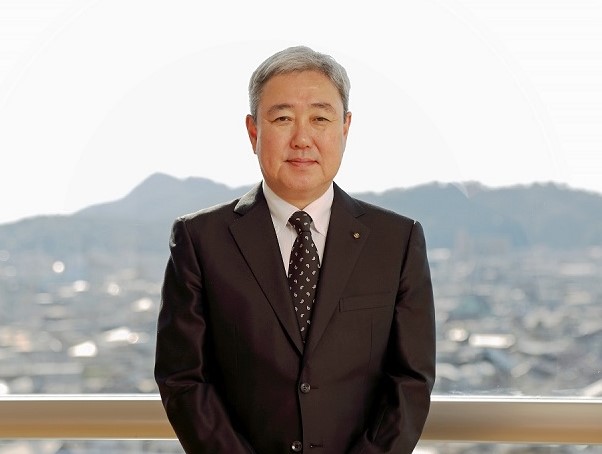Message from Top Management



SHIMA SEIKI will achieve a return to
profitability in the year,
the final year of the medium-term management plan,
and seek sustainable growth.
Mitsuhiro Shima, President

- Review of the first half of the period

- We conducted activities globally to propose a wide variety of products, services, and solutions supporting sustainable production for customers.
For the first half of the period (fiscal year ending March 2024), during a situation where there was a global recovery in the willingness to make capital investments in the apparel and fashion industry, we conducted activities globally to propose a wide variety of products, services, and solutions supporting sustainable production for customers. The difficulty in the procuring parts and materials was relieved after the start of the year, which made it possible to achieve timely production.
In the flat knitting machine segment, there was weakness in capital spending in the main market of China due to the delayed recovery, while there were new investments in the SWG-XR WHOLEGARMENT flat knitting machines by major Hong Kong-based customers and a net sales increase in WHOLEGARMENT flat knitting machines in the Italian and Japanese markets. Additionally, there was a sales increase in molding machines offering high production efficiency in Bangladesh and Vietnam. In the design system segment, for APEXFiz, which is a subscription service for the SDS-ONE APEX software, there was an increase in licensing agreements mainly with apparel brands in the United States, Europe, and Japan. Furthermore, there was a sales increase in the P-CAM automatic cutting machine mainly in the Japanese market with the broadening of the customer base to industries other than the apparel industry, such as automotive and industrial materials.
As a result of the above, for the first half, consolidated net sales amounted to \19,169 million, up 7.0% YoY. Operating income amounted to \367 million (operating loss of \435 million for the same period of the previous year), ordinary income amounted to \564 million (ordinary loss of \207 million), and quarterly net income attributable to owners of the parent amounted to \368 million (quarterly net loss attributable to owners of the parent of \511 million) due to an improvement in gross profit margin arising from stable production and control of selling, general, and administrative expenses. The Company was successful in achieving a profit.

- Prospect for the second half

- We will continuously strengthen proposal activities according to the status of the markets.
The global economy remains uncertain, and it is expected that capital spending will still be severe in the apparel and fashion industry. Even in such an environment, We will continuously strengthen proposal activities according to the status of the markets.
At ITMA 2023, the world’s largest international textile and garment technology exhibition held in Milan, Italy, in June 2023, we exhibited many new machines, including the SWG-XR WHOLEGARMENT flat knitting machines under the concept of Reborn, and these machines were appreciated by visitors. Even after the exhibition, we received many global inquiries about these proposals. For the second half, we will progress with the construction of the production system for new models and the mass production of a prototype early, while increasing orders by individually visiting customers for finely-tuned proposal activities.
The ITMA ASIA+CITME (Shanghai, China) held in November was the first time in several years that we had an excellent opportunity to directly present our new technologies to customers in the major markets of China and Asia. We would like to increase revenue for the second half by using the exhibition to strongly insist on the value of our products and solutions, realizing an increase in productivity and the added value of business.
The full-year consolidated earnings forecast is as announced in May 2023, with net sales of \43,000 million, operating income of \1,000 million, ordinarily income of \1,700 million, and net income attributable to owners of the parent of \1,200 million.

- To shareholders

- We will focus on efforts for further improvement in business results and an increase in the return on capital from the mid- and long-term perspectives.
This period is the final fiscal year of the medium-term management plan “Ever Onward 2023.” In the medium-term management plan, which started during the COVID-19 pandemic under the slogan "Transformation and Regeneration," what I have consistently aimed at is change in mindset for bringing the conventional way of doing things from zero. It is not necessary for us to keep doing things just because it was the conventional way of doing them for years. Now, we can stop doing what is unnecessary, change what must be changed, and keep what is required. This should be done immediately. I believe that a change in the consciousness of each employee is an essential condition for future sustainable growth.
To encourage freewheeling thinking beyond the exiting framework and immediate action, it is necessary to change the climate of the workplace. Therefore, we have increased opportunities to communicate with middle-level leaders to make an appeal to them that it is important to change the corporate climate while having built the environment that includes the establishment of intrapreneurship where young employees can try new ideas through freewheeled thinking.
A new medium-term management plan will start in the following period (fiscal year ending March 2025). The plan is based on the unconventional process of communicating with both management and young staff for its completion. We would like to create an environment where each employee individually has a dream as a person concerned and can grow through such efforts.
To increase shareholder value, we will make efforts to achieve a return to profitability on a company-wide basis. In addition, we will focus on efforts for further improvement in business results and an increase in the return on capital from the mid- and long-term perspectives while hearing the opinions of shareholders.
We look forward to the continued understanding and support of our shareholders for our group.



